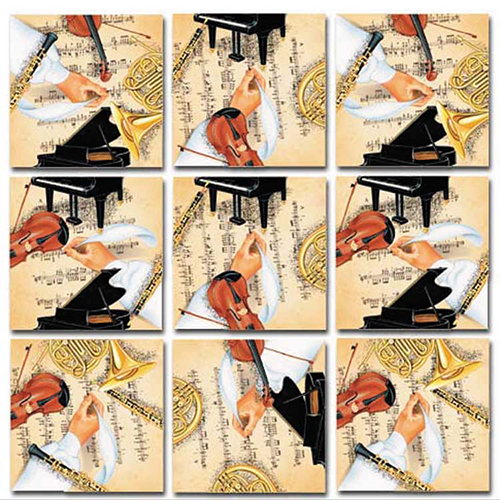Description
A surprise best seller, the Symphony Scramble Squares® has hit a responsive chord as a gift for children learning to play musical instruments and music lovers and concert goers of all ages.
Fascinating Facts
A symphony is a classical musical composition of complex harmonies written for the variety of instruments that comprise an orchestra. Symphonic compositions became a standardized musical form during the “Classical Period” of musical history from the mid-1700s to about 1820.
The Christian Church had led music out of the Dark Ages around 500 AD, when Roman Catholic Pope Gregory I developed the musical prayers now known as Gregorian Chants. During the Middle Ages that followed, secular music sung by troubadours began to emerge throughout Europe and flourished into the Renaissance Period, which began the rebirth in Europe and the British Isles of humanism in art, drama, music and dance at the beginning of the 15th Century.
Following the Renaissance, the style of musical compositions written by composers such as Johann Sebastian Bach in Germany, Antonio Vivaldi in Italy and George Frederic Handel in England became very ornate as did the architecture and art of that period, referred to as the “Baroque Age,” which began at the beginning of the 17th Century and extended into the mid-18th Century. Classical Period composers like Wolfgang Amadeus Mozart, Franz Joseph Haydn, Franz Schubert and Ludwig van Beethoven had come from throughout Europe to congregate in Vienna, Austria, Europe’s new musical center, and developed the Viennese style of music. The Viennese style, sponsored by Europe’s new aristocracy, became a less extravagant, more straight forward style of melodic music than the earlier baroque compositions commissioned by the Church or by royalty. Composers of this Classical Period believed that their new form of music reflected the elegant simplicity of the Classical Age of ancient Greece. It was Johann Stamitz, who, during this Classical Period in Vienna, developed the concept of the multiple types of instruments that would form an orchestra and the complex pieces of music that skilled orchestra musicians would play together on these various instruments to create an orchestral symphony.
A symphony orchestra is comprised of four categories of instruments: brass, percussion, strings and woodwinds. Brass instruments are made of long metal tubes of brass or other metals that are coiled in ways that amplify the sound vibrations made by air forced through the tension of the musician’s lips on the horn’s mouthpiece. The French horn is the leader of the orchestra’s brass section. Stringed instruments make music from the vibrations of their strings, which are either plucked by the musician’s fingers or rubbed by the musician with a bow, which is a stick with horse hair or nylon strands stretched along it. The violin is the leader of the string section, and the first violinist is second to the orchestra conductor as the leader of the orchestra. Although a piano is essentially a horizontal harp whose strings vibrate to make its musical sounds, the piano is actually a percussion instrument, because it uses small hammers leveraged to hit the harp’s strings when the musician depresses the piano’s keys. The piano was invented by Bartolomeo Cristofori under the patronage of the Medici family in Florence, Italy at the end of the Baroque Age of music. Because a pianist can use all ten fingers simultaneously on a variety of note keys and can contribute to the volume, tone and length of sound by using the piano’s pedals to shift the hammers, the piano can make the widest range and most complex music of any musical instrument. The oboe is a woodwind that became popular in France during the Baroque Age. Any instrument that makes sound vibrations when the musician blows over it or through it is considered a woodwind instrument, although today these instruments, including the oboe, flute, piccolo, clarinet, bassoon, contrabassoon and saxophone, may be made from wood, metal or plastic. Flutes and piccolos are played by blowing air over the openings in these instruments. The other woodwinds, such as oboes, clarinets, bassoons, contrabassoons and saxophones are played by blowing air through reeds which vibrate sound through the instruments. Unlike clarinets and saxophones, which are single reed woodwinds, oboes, bassoons and contrabassoons each employ double reeds to produce a more hollow, haunting sound.





Reviews
There are no reviews yet.